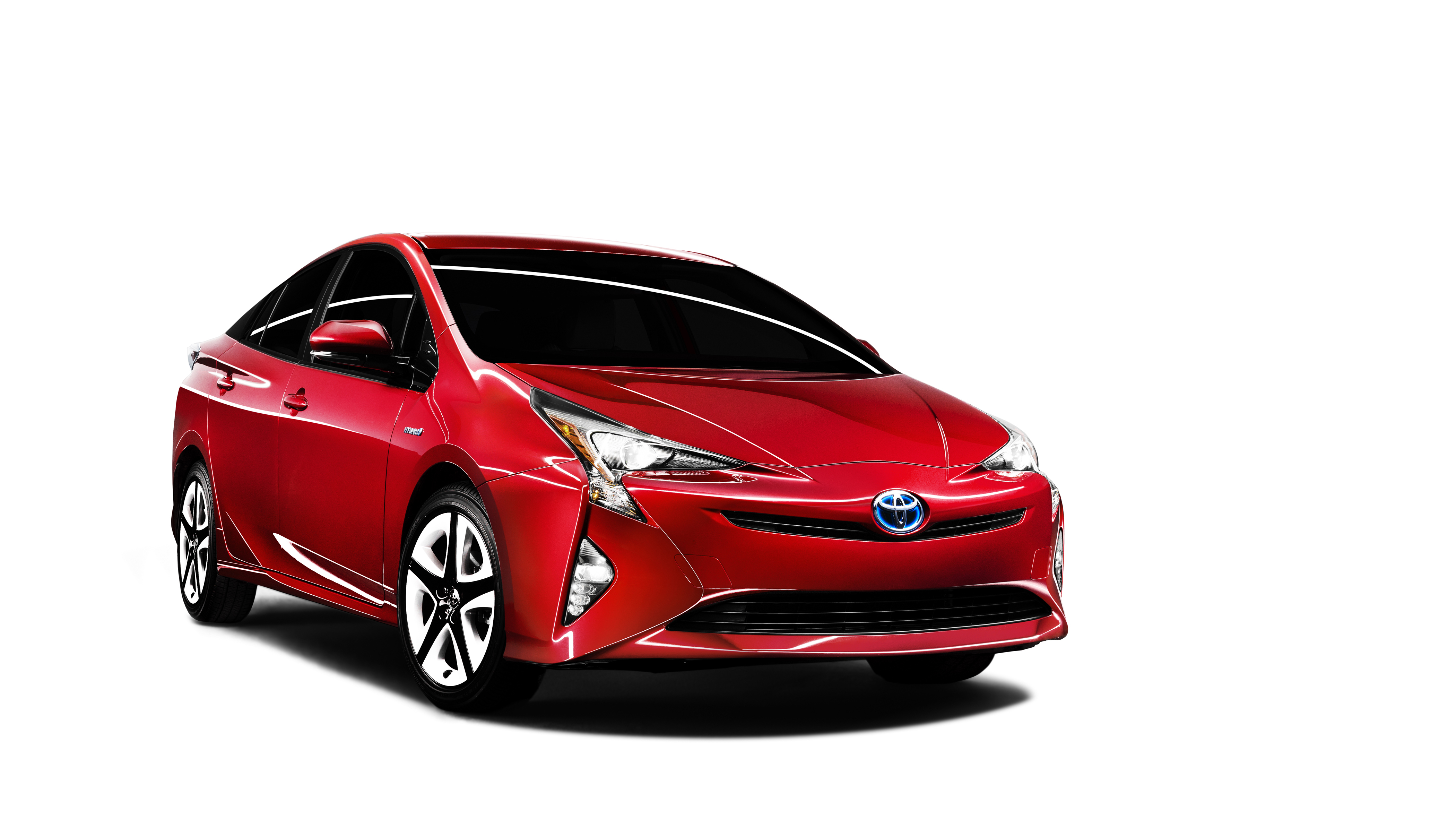 丰田公司在2016普锐斯的车尾上安装了“独特且令人瞩目的组合灯”,有助于消费者将其与前几代普锐斯区分开来。
丰田公司在2016普锐斯的车尾上安装了“独特且令人瞩目的组合灯”,有助于消费者将其与前几代普锐斯区分开来。 根据用户反馈,丰田决定在新内饰中“融入高科技”,提供更多功能,并使其“具有视觉冲击力。”
根据用户反馈,丰田决定在新内饰中“融入高科技”,提供更多功能,并使其“具有视觉冲击力。” 新普锐斯比旧版长了2.4 in (61 mm),宽0.6 in (15 mm),高度低了0.8 in (20 mm),并且室内空间和后备箱空间也有所提升。
新普锐斯比旧版长了2.4 in (61 mm),宽0.6 in (15 mm),高度低了0.8 in (20 mm),并且室内空间和后备箱空间也有所提升。 丰田设计师为新普锐斯设计了数条从前翼子板沿着车身侧面延伸出来的“大胆的线条”。从车窗延伸而来的曲线直接扫过后翼子板的上方,而上面那条折痕则融入降低了的后扰流板。
丰田设计师为新普锐斯设计了数条从前翼子板沿着车身侧面延伸出来的“大胆的线条”。从车窗延伸而来的曲线直接扫过后翼子板的上方,而上面那条折痕则融入降低了的后扰流板。 丰田表示,普锐斯全新的后端双叉骨悬架可让驾驶员更好地感受路面,因为它能在所有驾驶条件下提供更好的控制与反馈性能。更坚固的车身结构也有助于提升转弯时的反应灵敏度。
丰田表示,普锐斯全新的后端双叉骨悬架可让驾驶员更好地感受路面,因为它能在所有驾驶条件下提供更好的控制与反馈性能。更坚固的车身结构也有助于提升转弯时的反应灵敏度。 2016普锐斯将有7种车身颜色可供选择,其中包括全新的“超音速红”。这款新色彩采用了一种全新的制作工艺,“可将车身形状完美凸显出来”。
2016普锐斯将有7种车身颜色可供选择,其中包括全新的“超音速红”。这款新色彩采用了一种全新的制作工艺,“可将车身形状完美凸显出来”。 普锐斯宽大的仪表板不仅功能齐全,而且还呈现出一种“舒适而宽敞的感觉”。
普锐斯宽大的仪表板不仅功能齐全,而且还呈现出一种“舒适而宽敞的感觉”。 新普锐斯的内饰特点包括全包裹仪表板、人体工学座椅、舒适的控制设备和更宽阔的视野。
新普锐斯的内饰特点包括全包裹仪表板、人体工学座椅、舒适的控制设备和更宽阔的视野。
今年九月上旬,丰田公司在拉斯维加斯为2016年第四代混合动力普锐斯举行了一场发布会,这也是丰田历史上最大规模的发布会,共招待了350名宾客。之前,坊间一直流传着新普锐斯的造型与图纸,这场发布会意在破除流言,重点在展示新普锐斯的外貌,而非强调细节。
有一个细节值得瞩目:尽管在过去15-20年间,普锐斯的全球累计销量高达350万辆以上(在丰田的800万总销量中占据了相当可观的比例),但现在,丰田似乎想要将其改头换面,希望这辆外形俊俏的混合动力车能够吸引新的用户进入混动市场。在忠诚度方面,普锐斯已经在丰田所有车型中名列前三了。
丰田自己也表示,2016普锐斯“具有引领全新混合动力时代的惊人的外观。”除了外观的重新设计之外,性能也是重点改善的内容之一。“我们采用了一个全新的平台和后部双叉骨悬架,让驾驶性能提升了一个档次。”丰田集团副总裁兼汽车部门总经理Bill Fay在发布会上表示,“过去就有许多消费者关注燃油经济性,强调理性消费,而现在他们对这一点更加重视了。”
丰田称这个“彻底翻新的”普锐斯外观的设计灵感来自于起跑线上的赛跑选手。“这个运动感十足的设计表现出了一种前进的动态”,丰田希望借此吸引更多用户冲向它。重新设计的内容包括降低引擎盖的高度和让车顶前倾。在尺寸上,新普锐斯比旧版长了2.4 英寸 (61 mm),宽0.6 英寸 (15 mm),高度低了0.8 英寸 (20 mm),并且室内空间也有所提升。
新的标准LED前大灯可以有效减小普锐斯的车头面积,“这有助于定义汽车的性格”。正如丰田自己形容的那样,车尾的组合灯非常“独特”,而且延续了从后扰流板到侧边后缘的曲线。
在技术细节方面,诸如哪些车型使用哪些电池(镍-金属氢化物电池还是锂离子电池)、丰田的新全球架构(TNGA)、以及是否会推出全轮驱动版本等疑问,丰田汽车运营高级副总裁Bob Carter表示,目前无法透露更多信息,但10月下旬东京车展上“丰田将会让你惊讶得hold不住。”
就目前而言,丰田仅透露新普锐斯将具备更小、更轻的混合动力系统部件;更高的电池能量密度;以及一个“热效率史无前例的(超过40%)”的内燃机(可能是1.8 L)。这些结合起来将使整车的燃油经济性提升10%。在发布会上,丰田表示在日后还将推出一款环保的Eco车型,它的燃油经济性数据还将更为出色。
2016普锐斯是全球首辆TNGA车型。TNGA是丰田公司的一个将传动系统部件与汽车平台研发加以整合的项目。该项目的主旨是通过具体研发项目的战略组合,让不同车型更好地共享汽车部件,从而将资源利用率提高20%以上。拿普锐斯举例,新车型具备重心更低、反应更灵敏的悬架系统(其中包括全新的车尾双叉骨设计),这便是实施TNGA的结果。
据称TNGA也将使车身结构更坚固,上部车身的构造能够分散正面冲击能量,从而为乘客提供更好的保护。
预计新版普锐斯将于2016年早些时候正式上市。
作者:Jean L. Broge
来源:SAE《汽车工程杂志》
翻译:SAE 上海办公室
Toyota gives a look at its re-engineered 2016 Prius
While Toyota threw quite the launch party in early September in Las Vegas—a first for the company—to enable over 350 guests to get an official look at the 2016 fourth-generation Prius hybrid as opposed to subsisting on leaked images and suspect drawings, the party was most definitely more about looks than details.
One detail that did become clear was that even if over the last 15-20 years the Prius has accounted for more than 3.5 million in global sales (a good chunk of Toyota’s overall 8 million hybrid units), Toyota now seems to want the Prius to be viewed as just another pretty face, albeit one that happens to be a hybrid, hoping that the vehicle’s design will tempt new buyers to enter the hybrid market. It is already among the top three of Toyota vehicles in terms of loyalty rates.
If Toyota says so itself, the 2016 Prius features a “striking exterior design [that] ushers in [a] new hybrid era.” Besides the look of its redesigned exterior, emphasis has also been placed on performance with a “new platform and rear double wishbone suspension [that] dial up driving dynamics.” As Bill Fay, Group Vice President and General Manager, Toyota Division said at the event, “What was once a rational purchase that for many customers focused on fuel economy, is now so much more.”
Toyota says its rationale behind the “completely reimagined” Prius’ exterior was inspired by a runner in the starting blocks, with a “sporty design that conveys a feeling of forward motion” that it hopes will having future customers running toward it. Part of that design consisted of the vehicle’s hood being made lower and the roof peak moved forward. Overall, the new Prius is 2.4 in (61 mm) longer, 0.6 in (15 mm) wider, and 0.8 in (20 mm) lower with more interior space than the model it replaces.
New standard LED headlamps were placed to minimize the Prius’ front fascia and “help define the vehicle’s character.” The rear combination lamps are certainly “unique” as Toyota describes and follow along the lines from the rear spoiler to the trailing edges of the sides.
In terms of the details about some of the technologies that make up the Prius, including which battery options (nickel-metal-hydride vs. Li-ion) will be available for which vehicles, more detail on Toyota’s New Global Architecture (TNGA), and confirmation or denial about an all-wheel drive version, Bob Carter, Senior Vice President—Automotive Operations, said that Toyota is holding onto that information and more until the Tokyo Motor Show in late October, when the company will “give you all the specs you can stand.”
For now, Toyota teases that the vehicle will have smaller, lighter hybrid system components; higher energy density in the batteries; and an internal combustion engine (probably 1.8 L) touting “ground-breaking thermal efficiency” (more than 40%), that will all contribute to about a 10% fuel economy improvement. Hinted at the Prius reveal, Toyota says an Eco model, to be unveiled at some other future date, will achieve an even greater improvement.
The 2016 Prius is the first global vehicle to implement TNGA, which is an integrated development program for powertrain components and vehicle platforms. Vehicle development is strategically grouped to promote better sharing of components to improve resource efficiency by over 20%. Just a sampling of the benefits the Prius reaps via the use of the TNGA is a lower center of gravity and a more responsive suspension package that includes the new rear double wishbone design.
TNGA is also expected to provide a more rigid structural framework to help enhance occupant protection with an upper body designed to distribute frontal collision impact energy.
The vehicle is expected to be in dealerships in early 2016.
Author: Jean L. Broge
Source: SAE Automotive Engineering Magazine
等级
打分
- 2分
- 4分
- 6分
- 8分
- 10分
平均分
